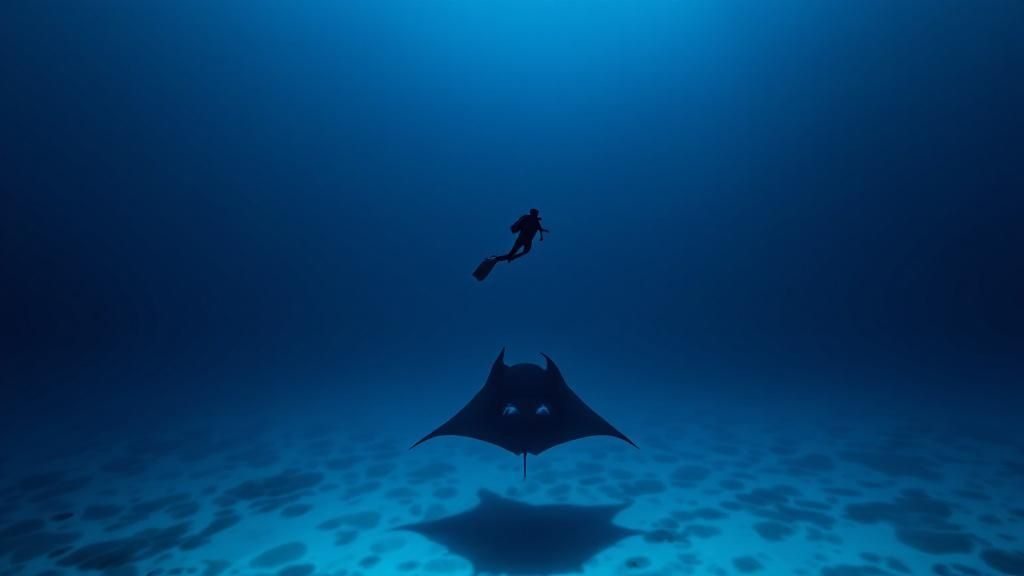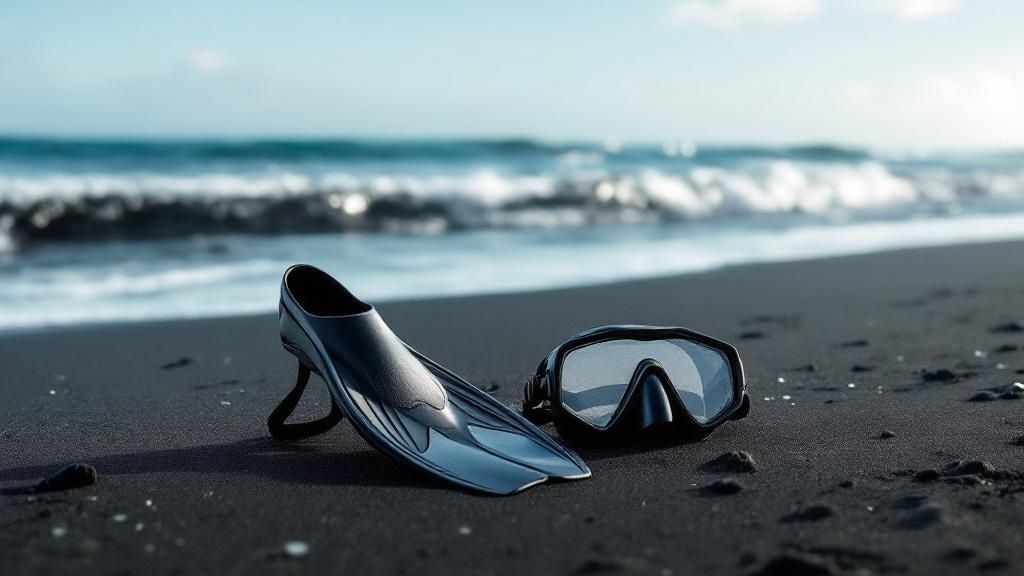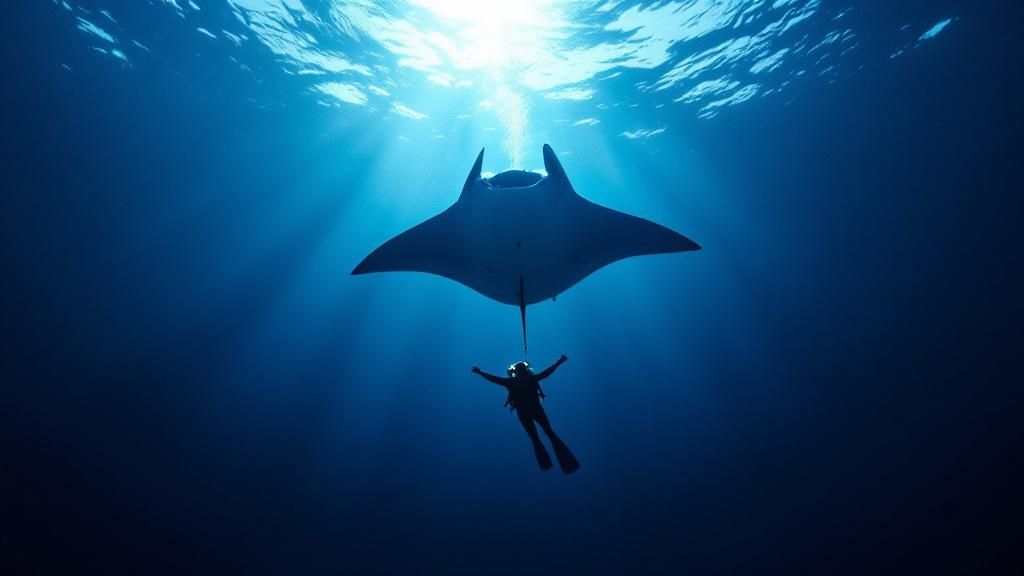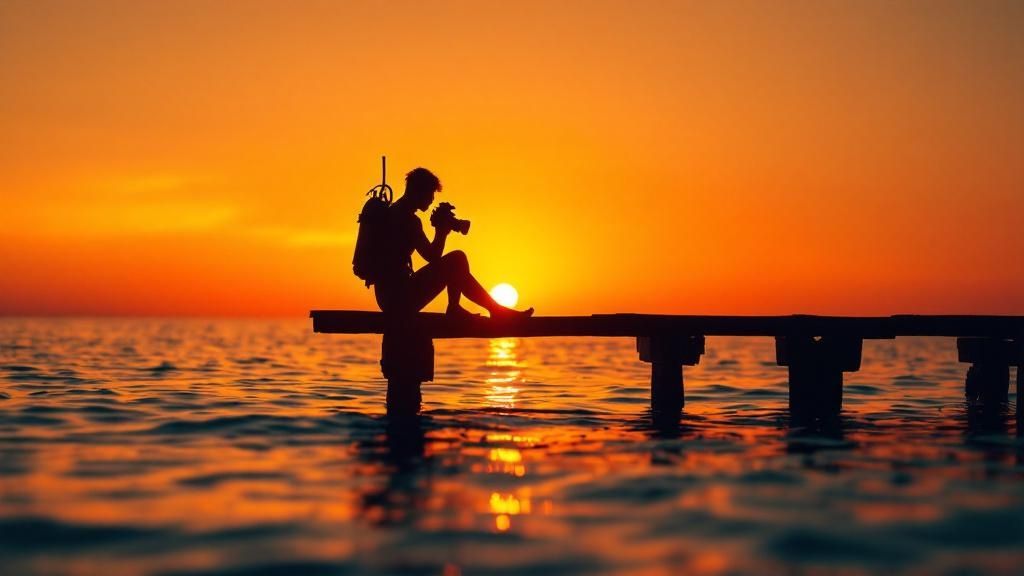The manta ray dive in Kona is hands-down one of the most reliable and awe-inspiring wildlife encounters on the entire planet. It's a true bucket-list experience, bringing you incredibly close to these gentle giants as they feed. Imagine a ballet of massive, graceful creatures in their natural habitat—it’s an unforgettable night, both under the stars and in the water.
For the best possible adventure, most people find the conditions are perfect between April and October.

An Overview of Your Kona Manta Adventure
Kona isn't just a place where you might see manta rays; it's a world-class destination practically built around this nightly spectacle. The sheer consistency and magic of this encounter draw about 80,000 people to the Kona Coast every single year. You can get a feel for how popular these tours are by checking out operators like Kona Honu Divers.
This incredible opportunity is all thanks to a couple of world-famous locations:
- Manta Village (Keauhou Bay): This is the original site, just south of Kailua-Kona. It's known for being the most consistent viewing spot.
- Manta Heaven (Garden Eel Cove): Found north of Kona near the airport, this spot is famous for sometimes attracting even larger groups of mantas.
If you're planning your own manta ray dive in Kona, aiming for a trip between April and October is a smart move. During these months, the Pacific waters tend to be calmer and warmer, usually sitting at a comfortable 75–80°F. This makes for a much more pleasant experience, whether you're diving down or snorkeling at the surface.
Making the Right Choice for Your Trip
Your first big decision is choosing how you want to see the mantas: snorkeling or scuba diving? It's a critical choice that shapes your whole experience.
Snorkelers float at the surface, holding onto a specially designed light board. This light attracts the plankton, which in turn draws the manta rays up from the depths to feed right below you. Scuba divers, on the other hand, get to descend to the sandy bottom, settle in, and look up. From there, you get a panoramic, theater-like view of the entire underwater ballet.
The core difference is your perspective: are you looking down from the surface (snorkeling), or are you looking up from the ocean floor (diving)? Both offer a spectacular show, but diving puts you right in the middle of the action for a truly immersive view.
To help you figure out what's best for you, here’s a quick comparison of the key factors. This should give you a solid starting point for picking the right tour for your comfort level and adventure goals.
Kona Manta Ray Encounter At a Glance
| Factor | Snorkeling | Scuba Diving |
|---|---|---|
| Certification | None required | Open Water certification needed |
| Best For | Families, beginners, non-swimmers | Certified divers seeking immersion |
| Perspective | Top-down view from the surface | Bottom-up view from the ocean floor |
| Depth | At the surface | Approx. 25-40 feet |
No matter which you choose, you're in for a treat. The key is picking the adventure that you'll feel most comfortable and excited about.
What Makes Kona the World's Best Manta Encounter?
Kona isn't just another great place to dive with manta rays; it's a world-class spectacle with a story that perfectly blends science and geography. The experience here is so consistent and breathtaking that it has put the Big Island on the map for divers globally. So, what is it about this one specific spot on Earth that makes it so uniquely perfect for meeting these gentle giants?
The magic all comes down to a simple, brilliant concept affectionately known as the "manta campfire."
Imagine this: dive operators place powerful, lighted rafts on the surface or lights on the ocean floor. These lights act like giant bug zappers in reverse, drawing in swarms of microscopic plankton. For the mantas, this glowing cloud of life is an irresistible, all-you-can-eat buffet that reliably appears night after night.
The Perfect Recipe for a Manta Feast
This nightly banquet isn't just a lucky break. The Kona coast's unique volcanic underwater landscape forms natural coves and bays. These formations act as giant bowls, keeping the plankton contained and preventing strong currents from washing the meal away.
Mantas are incredibly smart and creatures of habit. They've learned over decades that these specific spots—like the famous Manta Village and Manta Heaven—are a dependable food source. It's a dinner bell they can count on.
This unique setup is what makes the manta ray dive kona experience so different from other famous manta locations. Most other spots rely on "cleaning stations," where mantas visit to have smaller fish clean them. While cool to see, it doesn't compare to the dynamic, acrobatic feeding frenzy you'll witness in Kona.
Kona's encounter is a predictable feeding event, not a chance sighting. This reliability is the core reason why Kona consistently delivers such an unforgettable show, night after night.
Unmatched Sighting Consistency and Clarity
The consistency of manta sightings in Kona is just staggering. Studies have tracked the encounters here for years, and the numbers speak for themselves. One comprehensive study found an average of 20 manta sightings per night at Kona's main sites. That's double the average of roughly 10 sightings in other popular locations worldwide.
On top of that, the water clarity is phenomenal. Visibility often reaches an incredible 100 feet, easily beating the 60-foot average you might find elsewhere.
This exceptional clarity gives you a crystal-clear, front-row seat to the ballet. Whether you're a diver watching from the seafloor or a snorkeler floating above, the view is simply unparalleled. You can learn more about what makes the manta ray night dive in Kailua Kona so special in our detailed guide.
Ultimately, it’s this powerful combination of predictable science, perfect geography, and stunning visibility that makes Kona the undisputed champion for a magical manta encounter.
Choosing the Right Manta Ray Tour Operator

This is probably the single most important decision you'll make when planning your trip. Picking the right company for your manta ray dive in Kona can mean the difference between an unforgettable, magical encounter and a total bust. With dozens of boats heading out every single night, I know the options can feel pretty overwhelming.
Your goal is to find an operator that puts three things first: your safety, the mantas' well-being, and a fantastic experience for you. The best companies aren't shy about their professional credentials; they’ll proudly show off their PADI or NAUI affiliations, which are the gold standard in the diving world.
Key Factors for Vetting Operators
When you start digging in and comparing your options, you've got to look past the price tag. The best operators pour money and effort back into their equipment, their crew, and their safety protocols. That investment shows.
A huge green flag for a responsible company is their commitment to the established Manta Ray encounter guidelines. Years ago, there was a "Manta Ray Green List" that really set the bar for ethical operations. While that specific list isn't updated anymore, the core principles are still what separate the great from the mediocre. Don't be afraid to ask a potential operator how they follow those rules today.
The golden rule is passive observation. This is non-negotiable. It means you absolutely cannot touch, chase, or block a manta's path. Great operators are strict about this because touching a manta can damage the delicate mucous layer on their skin, which is basically their immune system.
Another dead giveaway of a quality tour is a low guide-to-guest ratio. Smaller groups just make for a better, safer, and more personal time in the water. You get more attention from your guide and a less crowded, more intimate view of the mantas. To get a head start, you can find a solid breakdown of the top 10 Kona dive shops and see what makes the best outfits tick.
Practical Questions to Ask Before You Book
Once you’ve narrowed it down to a few contenders, it's time to get into the nitty-gritty. Asking the right questions can tell you everything you need to know about the kind of experience you're signing up for.
- Safety and Gear: What’s your guide-to-diver ratio? How often do you service your rental gear? Do you provide wetsuits, and what thickness are they? (Trust me, you'll want one!)
- Boat Amenities: How big is the boat? Is there a marine head (toilet) on board? What about snacks, drinks, or a hot shower after the dive?
- Logistics and Policies: What happens if you need to cancel? Do you offer a "manta guarantee"? Many shops will let you come back for free on another night if the mantas don't show up.
Finally, do your homework and read recent, detailed reviews on Google or TripAdvisor. Look for comments about the crew, the boat's condition, and how the guides handled the actual dive. A little bit of research upfront ensures you book a trip that not only gives you a spectacular show but also helps protect Kona's amazing manta ray population for years to come.
How to Prepare for Your Manta Ray Night Dive

A little prep work can be the difference between a good trip and an absolutely unforgettable one. Getting ready for your manta ray dive in Kona is pretty straightforward, but a few key steps will help you feel comfortable, confident, and ready to soak in every second of the magic. This advice goes for both the snorkelers and the scuba divers out there.
Your journey starts long before you ever step foot on the boat. Being physically ready is a big part of feeling comfortable and safe in the water. To make sure you have the energy needed, you might want to improve your stamina in the weeks before your trip. You’d be surprised how tiring even a simple snorkel can be in the open ocean.
When it's finally time to pack your bag for the tour, think warm and cozy. Even after a beautiful, warm Hawaiian day, the boat ride back can get surprisingly chilly once you’re out of the water and the wind picks up.
Your Essential Packing Checklist
Your tour operator will have all the big stuff covered—wetsuits, masks, snorkels, and fins. Still, a few personal items will make a world of difference for your comfort. Here’s a quick list of what you should definitely toss in your bag:
- A Warm Change of Clothes: Seriously, a dry hoodie or a windbreaker for the ride back is a lifesaver. You'll thank me later when you’re not shivering on the way to the harbor.
- Reef-Safe Sunscreen: If you're on one of the sunset tours, slather this on before you go. Regular sunscreens have chemicals that are incredibly damaging to our precious coral reefs.
- A Towel: Most boats don’t provide towels, so be sure to bring your own for drying off.
- Motion Sickness Medication: If you even think you might get seasick, take your preferred remedy before getting on the boat. It works so much better if you take it ahead of time.
Understanding the Golden Rule of Observation
Once you're on the boat, the crew will walk you through a detailed pre-dive briefing. They’ll go over all the safety stuff, what to expect, and share some really cool facts about the mantas. Listen up, because this is where you’ll learn the single most important rule of the night.
The number one rule is passive observation. Think of it this way: you are a visitor in the mantas' house while they're having dinner. This means no touching, no chasing, and no getting in their way as they swim and feed.
Touching a manta ray can actually harm it by rubbing off the protective mucous layer that guards it against infection. Good, responsible operators are very strict about this for the animals' well-being. Just relax and let the mantas lead the way—their natural curiosity often brings them incredibly close, all on their own terms. If you want to dive deeper into responsible tourism, you can learn more about why you should go on a manta ray dive in Kona.
Finally, it’s completely normal to feel a little nervous about swimming in the ocean at night. Don't hesitate to share any jitters with your guide. They are seasoned pros at making everyone feel safe and at ease, so you can focus on the amazing underwater show unfolding right in front of you.
How Your Dive Supports Manta Ray Conservation
https://www.youtube.com/embed/kOlm3LmcGl0
When you book a manta ray dive in Kona, you're doing so much more than just crossing an item off your bucket list. You’re stepping into one of the world's most successful examples of ecotourism, one that directly contributes to the survival of these gentle giants.
Think of it like this: your ticket sends a powerful economic signal. It declares that a living, healthy manta ray is far more valuable to the community than one caught or harmed. This simple financial truth creates one of the strongest possible incentives for conservation.
This unique model has reshaped Kona's relationship with its marine environment, proving that sustainable tourism isn't just a buzzword—it's a practical, powerful force for good.
The Power of Conservation Tourism
The manta ray viewing industry along the Kona Coast is a huge economic driver for the Big Island, especially at famous sites like Manta Village and Manta Heaven. This financial importance has led to serious safety standards and regulations designed to carefully manage every interaction, keeping both people and mantas safe. You can dive deeper into the official protective measures and their economic impact on Hawaii.gov.
By choosing to go on a tour, you’re directly fueling a whole ecosystem of conservation. Your money helps:
- Support Local Jobs: You're paying the wages of local guides, boat captains, and dive masters who are often the most passionate advocates for the ocean.
- Fund Research: Many tour operators collaborate with research organizations studying manta behavior, which helps us better understand how to protect them.
- Promote Awareness: Every single person who has this mind-blowing experience goes home as a new ambassador for manta rays, sharing their story and passion around the world.
By placing a high economic value on a living manta ray, the community has created a self-sustaining cycle of preservation. The more people who responsibly enjoy these creatures, the greater the incentive to ensure their habitat remains pristine for generations to come.
This perspective changes everything. Your dive isn't just a passive tour; it’s an active investment in the future of Kona's manta population. Understanding what it's like to go on the manta ray dive in Kona, Hawaii really brings home how your presence is part of this vital conservation loop.
Ultimately, when you choose a reputable, safety-conscious operator, you ensure your dive is both magical and meaningful. You'll leave with more than just photos and memories—you'll leave knowing your adventure made a real, positive difference.
Answering Your Manta Ray Dive Questions

Planning an epic adventure like a manta ray dive in Kona is exciting, but it’s natural to have questions. Getting the details ironed out beforehand is the key to feeling confident and ready for your trip. Here, we'll tackle the most common things we get asked by visitors.
We’re going to cover everything from what happens if the mantas are a no-show to the real differences between the dive and snorkel experiences. By the end, you'll have all the info you need to book the right tour for you.
Are Manta Ray Sightings Guaranteed in Kona?
This is the big one, and for good reason! While manta rays are wild animals—so no one can offer an absolute 100% guarantee—Kona is one of the most reliable places on the entire planet to see them.
The secret to this consistency is the "manta campfire" effect. The tour boats' powerful lights attract a nightly feast of plankton, which has essentially trained the local manta population to show up for dinner almost every single night. In fact, most reputable operators have a sighting success rate well over 90%.
Many companies offer a "manta guarantee." If you're on one of the very rare trips where no mantas appear, you can usually rebook for free on another night. It's always a good idea to confirm this policy before you lock in your booking.
Here’s a pro tip: try to schedule your manta tour early in your vacation. That way, if you need to use that guarantee, you have a nice buffer to reschedule without messing up your other plans.
Snorkeling vs. Scuba Diving: What Is the Difference?
Choosing between snorkeling and scuba diving for the manta ray dive in Kona really comes down to the perspective you're after. Both are absolutely spectacular, but they are very different experiences.
- Snorkeling: You'll float on the surface, holding onto a custom-built light board. These bright lights draw the plankton up, and the mantas swoop in from the depths to feed just inches below you. It's a breathtaking top-down view of the action.
- Scuba Diving: If you're certified, you'll descend to the sandy ocean floor, usually around 25 to 40 feet deep. From there, you just sit or kneel and look up as the mantas perform an incredible ballet, gliding and barrel-rolling right over your head. It’s like watching a real-life IMAX movie unfold around you.
Snorkeling doesn't require any certification, making it a fantastic option for families, beginners, and just about anyone. Diving, on the other hand, gives you that fully immersive, 360-degree view that many seasoned divers crave.
Do I Need to Be a Certified Scuba Diver?
Yes, if you want to scuba dive with the mantas, you must be a certified open water diver. You'll need to present proof of your certification to the dive shop before the tour.
But if you're not a diver, don't worry! You absolutely do not need any certification to join the snorkeling tour. The experience is designed to be accessible for all ages and swimming abilities, and the large flotation boards provide excellent stability and support in the water.
A few companies might offer a non-certified "introductory dive" with a private guide, but that’s a specialized tour you would need to arrange and confirm well in advance.
Is the Manta Ray Night Dive Safe?
When you go with a professional and reputable tour operator, the manta ray dive in Kona is a very safe activity. The local industry has strong, self-enforced standards to protect both people and the marine life we love.
Crews deliver thorough safety briefings, the dive sites are well-managed, and the entire tour is structured to minimize risks. For divers, the dive itself is relatively shallow and stationary, making it much less complicated than a typical reef dive. For snorkelers, those big light boards create a stable and secure platform to hold onto.
The most important safety rule for everyone is to practice passive observation: never, ever touch the mantas. Touching them can remove their protective slime coat, which is essential for their health. This rule keeps both you and these magnificent gentle giants safe. For more on how the seasons can affect your trip, check out our guide on the best time of year to see manta rays in Kona.
